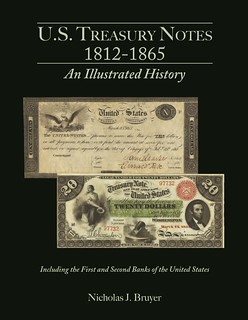
PREV ARTICLE
NEXT ARTICLE
FULL ISSUE
PREV FULL ISSUE
NEW BOOK: U.S. TREASURY NOTES, 1812-1865Last week we published a couple excerpts from the new book by Nicholas J. Bruyer on U.S. Treasury Notes. Here's the full announcement from publisher Stack's Bowers. -Editor
Peter Treglia, Director of Currency at Stack's Bowers Galleries stated "Nicholas J. Bruyer's insightful book not only sheds light on the importance of various types and issues of currency, but it also unravels the mysteries that collectors and scholars have long pondered. With meticulous research and a keen eye for detail, Bruyer masterfully connects the dots, providing the answers to longstanding questions. From the earliest days of U.S. issued Treasury Notes to the Civil War, this book serves as a definitive resource, furthering our understanding of our nation's monetary heritage. Prepare to embark on an enlightening journey as Bruyer weaves together the threads of history, offering profound insights and a newfound appreciation for the importance of early US Treasury Notes.
Treasury notes were authorized under the U.S. Constitution as
Drawing upon Treasury Department documents in the National Archives, Congressional records and contemporary
press accounts among other sources, Mr. Bruyer explores the use of Treasury notes by a succession of Treasury
secretaries to meet the nation's financial needs during the War of 1812, the Panic of 1837, the Mexican War, the
Panic of 1857 and the War of Rebellion. The greatest use of Treasury notes occurred during the Civil War under
Treasury Secretary Salmon P. Chase, who initially believed he could pay the entire cost of winning the war solely
using Treasury notes, without new taxes or bonds. As the war progressed, Chase experimented with different kinds
of Treasury notes, including coupon-bearing notes, before settling upon a 6% note yielding compound interest in
June 1864. United States Treasury Notes is the most extensively illustrated of any reference work yet published on the subject. Most notes are shown in color and include specimens from major auction houses and the Smithsonian Institution. Many are rare or even unique, the only known surviving examples. Individual notes illustrated in book have sold for upwards of $1 million at auction.
Students of Civil War currency may be surprised to learn that the non-interest bearing
The book also dedicates space to the periods before and after the War of 1812 with chapters on the First (1791-1811) and Second (1816-1836) Bank of the United States. Arguably, if either institution had survived the politics of
its times, there would have been no need for the U.S. government to issue its own circulating currency. However,
growing distrust of British shareholders, who owned a majority of the First U.S. Bank at a time of increasingly
prickly relations with the British government, sealed its fate. The Second Bank fell victim to President Andrew
Jackson's dislike of bankers in general and what he called the
Anyone interested in the monetary history of the United States and its paper money, from the beginning of the
federal era through the end of the Civil War, will find United States Treasury Notes to be valuable as an introduction
and a foundational reference. Well-known author and currency specialist, Art Friedberg remarked In an email Stack's Bowers made these additional announcements of great opportunities at the upcoming ANA show. -Editor This new title will debut at the upcoming ANA World's Fair of Money convention in Pittsburgh at the Stack's Bowers Galleries table – #1000. In addition, Nick Bruyer will be on hand to meet attendees, talk paper money and personally autograph all copies of his soon to be best seller, offered at a special convention price of $30, a 50% discount to the cover price. Nick will also have an extraordinary million dollar display of Treasury Notes, from a $1000 note from the War of 1812, to a $50 7.3% "coupon" note issued from 1864 to the end of the Civil War. Also on display will be an unissued specimen of the first and only U.S. $3 note, from 1815; a $50 note from the Panic of 1837; the first "Demand" note ($50) from 1843; the first $5000 note, issued for the Mexican War in 1847; the first note issued for the Civil War, a unique 1861 $50 6% 2-yr note valued at $1 million; a proof $100 coupon-bearing 7.3% note of 1861; and a $100 1864 Compound Interest note.
To read the earlier E-Sylum article, see:
Wayne Homren, Editor The Numismatic Bibliomania Society is a non-profit organization promoting numismatic literature. See our web site at coinbooks.org. To submit items for publication in The E-Sylum, write to the Editor at this address: whomren@gmail.com To subscribe go to: https://my.binhost.com/lists/listinfo/esylum All Rights Reserved. NBS Home Page Contact the NBS webmaster 
|

